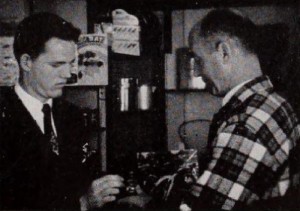"A short but poignant film of a crippled girl with a toy carousel which becomes very real to her. She dreams of visiting an amusement park." PSA Journal, Nov. 1956, 45.

"In a relatively short period of filming, Raymond J. Berger has mastered a type of photoplay which a great many persons have expressed a desire to make, the story film featuring a child and a pet. His script, a simple and unpretentious recounting of how an invalid child wills herself to walk again, to go to the aid of her injured dog, proves an ideal vehicle for Mr. Berger's young daughter and her handsome collie, Lassie. This 8mm. Kodachrome picture, scored with re-recorded music, is noteworthy for its excellent framing and splendid closeups. Particularly engaging is the sequence, after the accident, showing the mutual recovery of the two stars. Young Miss Berger, considering the limited histrionic ability of a natural child, plays her role with grace and assurance; her crying scenes and the ingenuous frolics with Lassie are unusually credible and well performed. Mr. Berger deserves credit for his planning and fulfillment of a screen play that revolves around two such charming personalities." Movie Makers, Dec. 1946, 486.
Documentary film chronicling the background and production of Dinosaur Dream (1995), which Sid Laverents made in his late-80s with assistance from his wife, Charlotte.

"The Marble begins with two boys fighting over a game of marbles, and as one boy, Larry, chases one of the little spheres into the street, he is hit by a car and ends up in the hospital. His friend is deeply hurt over this, for he realizes it is his fault. He prays, calls on the local minister, does all he can to get his friend Larry to live. While at the church he has a vision that Larry is in church with him; then, in a flash Larry is gone" PSA Journal, Sept. 1966, 35.

"In Maxine's Big Moment, William Messner proves that he knows the language of the motion picture, for he tells his tale in true visual terms. No subtitles are used, nor are they needed. This is a small film but a suave one, scarcely more than a vignette, as it recounts the excitement of a teen age girl's first formal dance. In it, the producer has used high key lighting that is eminently suitable in portraying a lovely young girl anticipating and preparing for a party. The choice of softcolor backgrounds adds immensely to the mood of the film, and the imaginative mirror shots in which the young lady pins a corsage to her gown are noteworthy. Fine editing and smooth transitions, in addition to good acting, combine to make a delightful and entertaining home movie." Movie Makers, Dec. 1948, 476.

"May Day Conflict is a well executed and skillfully edited family story film of the conflict created by the opening of the trout season and a flower festival both falling on May first. The central character is a good loser (the husband, of course!), as he accompanies his wife to the flower show after elaborate preparations for his fishing trip. Herbert F. Sturdy has deftly woven into the story pattern light, humorous incidents to provide amusing comedy relief from his fine floral closeup studies. Expert camera handling and smooth transitions lend a semi-professional finish to the picture." Movie Makers, Dec. 1948, 493-494.

The film depicts Mayan rites in 1930's Guatemala along with intertitles describing the destruction of Mayan temples by conquerers and the performance of traditional ceremonies at the steps of churches.
Travelogue of Rothenburg, Germany.
"An amusing, sophisticated treatment of a family Christmas. As the second film ever made by Mr. Hazard, "Merry Christmas" also won the first award and trophy at the 1955 Louisville international Exhibit of Photography. Excellent editing and directing result in the delightful skit of a tiny tot's premature discovery of Christmas tree and presents while parents are still sound asleep and of the mayhem that follows." PSA Journal, Dec. 1955, 35.
Total Pages: 39